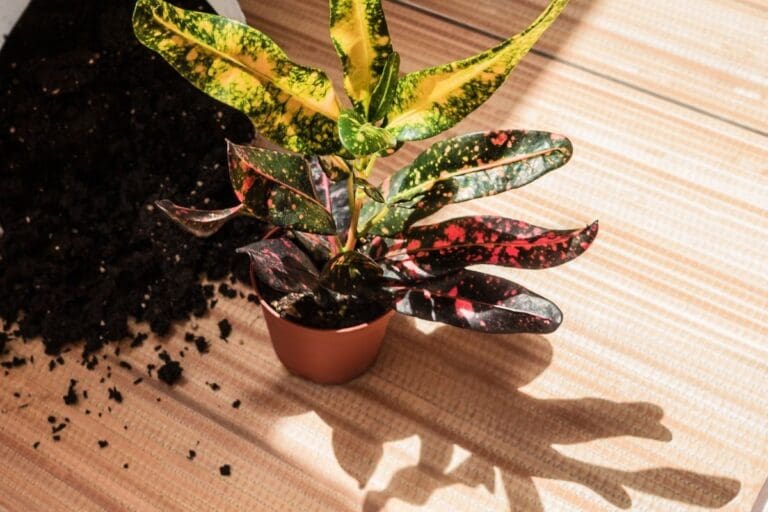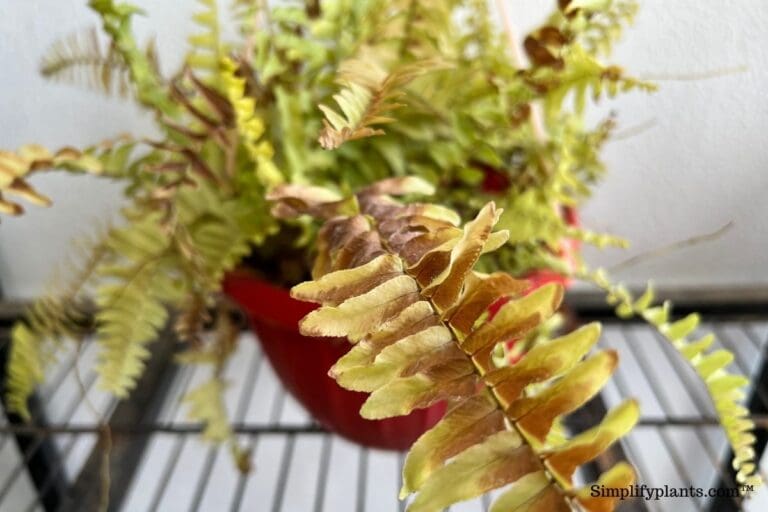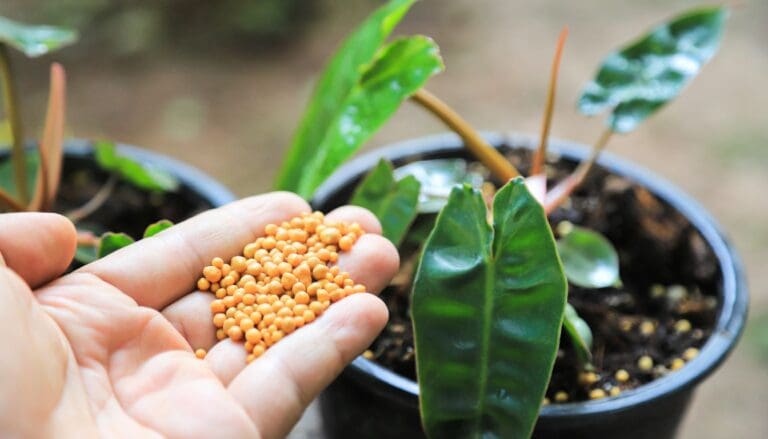Should I Fertilize Calathea? (How Often+Best Fertilizer)
While growing in their native land, Calathea gets all the required nutrients naturally from the soil. But, while growing indoors, it will not get the nutrients naturally. You will have to provide the nutrients in the form of fertilizers.
So a common question that comes to everyone’s mind is should I fertilize my calathea? How often? Let’s find out.
Generally, calathea does not need much fertilizer when grown indoors. However, fertilizing the calathea plant once a month during its growing season can help with prolific growth, healthy foliage, and occasional blooming. It is recommended to use a balanced 10:10:10 fertilizer for calathea plants.
In this article, you will get to know everything about fertilizing a Calathea plant. I will also let you know the best fertilizer for Calathea, how often to fertilize, and how to fertilize a Calathea.

Please note: Simplify Plants is reader-supported. Some links in the post are affiliate links and I get a commission from purchases made through links in the post.
Should I fertilize my Calathea?
Providing all your houseplants with an adequate amount of fertilizer is vital. When grown indoors, the plants don’t receive the same nutrients they used to get in their natural habitat.
The potting mix that you prepare for the plants holds nutrients for some time. After that, with each watering, they lose the nutrients. You can’t restore the soil with enough nutrients with little or no fertilizer.
Keeping these in mind, you should fertilize your Calathea during their active and growing season to keep them strong and healthy.
When you do not fertilize calathea, it will start becoming weak and show some unhealthy signs like:
- Slow growth
- Yellow leaves
- Stunted growth of the newly grown leaves
There might be other issues behind these symptoms, but one reason out of all can be that you are not fertilizing your calathea enough.
When should I fertilize my Calathea?
Before you learn about the right time to fertilize Calathea, you should never forget one primary point: not to fertilize Calathea during the winter months.
In winters, Calathea stops its growth. Belonging to tropical regions, Calathea will need a warm climate for growing actively. So, it won’t tolerate winter.
Some gardeners say that the Calathea enters a stage of dormancy where it rests, and thus it doesn’t grow.
Calathea either reduces their growth or stops their growth entirely because they cannot handle cold drafts. Thus you can say that Calathea remains nearly dormant in winters.
Now, coming to the main point about when to fertilize Calathea, they should constantly be fertilized starting from early spring to fall.
After that, as winter approaches, reduce the frequency of fertilizing and gradually stop it.
Generally, Calathea should be fertilized during the springs and summers, making the fertilizer half-strength with diluted water.
As they grow actively during the spring and summers, applying fertilizer would boost their growth and immunity and help them develop well.
When the winters are just starting, start reducing the frequency to once a month.
When the temperature drops too much, the plant will stop its growth, and you won’t have to fertilize them anymore. The duration of the winter season, however, depends on the region you stay in.
The plant will resume its growth with the arrival of early spring.
How often should I fertilize my calathea?

Calathea should be fertilized every 2 weeks by diluting the fertilizer and making it half-strength. You should fertilize them during their growing seasons, which are springs and summers.
During the winter, you should reduce the frequency to once a month.
Some gardeners even recommend fertilizing every 4 weeks during the spring and summers. During the winters, there is no need to fertilize.
How often should Calathea be fertilized depends on two factors – the area you live in and the surrounding environment.
If the area you live in is quite hot and temperature drop doesn’t affect the plant much in winters, you can fertilize them every 2 weeks in the growing seasons and reduce it to once a month in the winter.
But if your area is not that hot and undergoes cold winters, you can then fertilize your plant every 4 weeks with general fertilizer. During the winters, when the temperature drops too low, stop fertilizing.
Fertilizing a Calathea more during the summer and spring is beneficial because the plant grows rapidly under bright sunlight. Thus it uses more amount of fertilizer for more growth.
Some more recommendations regarding how often to fertilize Calathea would be:
- In medium bright light levels, fertilize Calathea 4 to 6 times a year.
- In low light levels, fertilize Calathea 2 to 3 times a year.
In bright light levels, the plant grows faster. The plants will use a lot of energy and nutrients for faster growth and thus take up the nutrients faster. That is why they need to be fertilized more frequently, at least 4-6 times a year.
But in low light conditions, the plant doesn’t use up so much energy and nutrients because of slower growth, and thus they won’t need fertilizer as often.
So, you can be conservative while fertilizing them in such a situation by giving them fertilizer 2-3 times a year.
If you don’t know the amount of light your Calathea is getting, you can remain on the conservative side. Giving your plant less amount of fertilizer won’t harm the plant.
Even if they are receiving their nutrients late, they won’t be deprived of nutrients. Using less fertilizer will save your plant from over-fertilization, which will cause serious issues.
Make sure you observe your plant’s reaction daily towards less application of fertilizers.
Understanding your fertilizer

Before finding out the best fertilizer for Calathea, you should understand your fertilizer.
You must first understand the NPK value of fertilizers. It will help you understand what would be the best one for your Calathea.
NPK stands for nitrogen (N), phosphorous (P), and potassium (K).
When I say fertilizer with NPK 10:10:10, it means a fertilizer containing equal and balanced macronutrients – 10% Nitrogen, 10% Phosphorous, and 10% potassium.
These three nutrients are the primary nutrients your plant needs for healthy growth. And the remaining percentage consists of the micronutrients like iron, calcium, sulfur, boron, magnesium, etc.
Nitrogen helps maintain the color and health of the Calathea leaves. Phosphorous promotes flowering and healthy roots, and potassium helps resist diseases, rapid growth, and other cellular functions.
Now, after knowing all these things, selecting the right fertilizer will be easy for you.
What is the best fertilizer for Calatheas?

For healthy growth and an appealing look, Calathea will need a balanced fertilizer with an NPK ratio of 10:10:10 or 20:20:20 but it should be diluted to half of the recommended dosage.
If you want your Calathea to bloom, you can use a fertilizer that goes a little high in phosphorous, such as a fertilizer with an NPK value of 10:15:10.
Some of the best fertilizers that I have used in the past are:
- Jacks Classic 20-20-20 All Purpose Fertilizer
- Triple 10 All Purpose Liquid Fertilizer 10-10-10
- Espoma Company Organic Indoor Plant Food
If you are more of an organic user than a chemical, you can try different organic materials as fertilizer for your Calathea plant.
You can use fish emulsions, organic compost, worm castings alfalfa meal, and aquarium water to provide more nitrogen to your Calathea.
For phosphorous, you can try rock phosphate and bone meal. And for potassium, you can use kelp meal and granite meal.
However, these don’t contain other micronutrients like iron, manganese, magnesium, boron, calcium, or sulfur. You will have to try other organic or homemade fertilizers like eggshells or coffee grounds.
How do you put fertilizer on calathea?

Before applying fertilizers, make sure to water your plant well. Don’t fertilize directly in dry soil. This can burn the roots.
Watering and then fertilizing will dilute the fertilizer and support even spreading the fertilizers to all portions of the roots.
To fertilize your plant:
- Gather your supplies. You will need a watering can or bucket, a liquid measuring cup, and your Calathea.
- Now comes the mixing of fertilizer with water. It is the tricky part as people get confused about how much quantity would work well.
- Excess can burn the leaves and roots. To avoid this, read the instructions given on the product label carefully.
- Go through all the ingredients, instructions about the quantity, direction of use, cautions, and danger columns.
- After reading and using the amount prescribed in the instruction column, mix the fertilizer with room temperature water and stir well until it dissolves fully.
- Now water your plant well until the excess water comes out of potholes. Ensure that your pot has drainage holes. This will allow even spreading of nutrients.
- Pour the fertilizer solution into the soil evenly around all sides. Avoid the leaves.
- If you use non-soluble fertilizers, sprinkle some fertilizers around the plant on the soil surface and water your plant very well. Do not sprinkle on the leaves to avoid leaf burns.
Another recommendation I would like to give:
Water your plant well.
Mix ¼ teaspoon of a balanced fertilizer with NPK 20:20:20 in room temperature water. Make the strength ½. Use filtered or distilled water.
Use this solution every month by replacing it with one watering. Pour it over the soil until the soil gets saturated and water comes out of drainage holes.
Your pot must have drainage holes. Put a tray or saucer under your potted Calathea.
Yellow leaves are a sign of chlorosis due to less fertilizer. If this happens, reduce watering and increase fertilizer potential from ¼ to ½ to give them the right amount of fertilizer.
Overfertilizing the calathea

Along with proper fertilizing, you should also check whether your Calathea reacts well to your way of fertilizing. Sometimes, people get confused and tend to overfertilize their calathea and increase various other issues.
Using less fertilizer doesn’t cause much problem as overfertilization does. Moreover, treating overfertilized plants is quite a difficult job.
Overfertilizing can result in the burning of the leaves and roots.
Calathea doesn’t need much fertilizing. This problem occurs mainly during the winters.
Some growers mistake stunted growth in winters as a sign of underfertilization and start fertilizing. This is wrong.
If your plant stops growing during winters, you don’t need to worry about it. It is natural. Thus, you need to avoid fertilizing in winters.
Some signs of an overfertilized calathea are:
- Burnt leaves
- Crispy leaves at the edges
- Entirely yellow or brown leaves
Don’t worry. To fix an over-fertilized Calathea, you need to flush off the soil. You can do this by sinking or showering the plant to leach out the soil.
For sinking:
- Fill a bucket with water and immerse your potted plant into it.
- Make sure the upper portion doesn’t touch the water. Keep it like that for some minutes or an hour.
- Take the pot out on time and allow all the excess water to drip out of the potholes. When it starts drying, take it back indoors.
For flushing the soil:
- Water your plant with a strong force and let the water come out of the drainage holes. All the accumulated salts from overfertilization will come out along with water.
- Water your plant again, but this time, water it less.
For showering the plant:
- Keep your calathea under running water.
- Wait until the excess water comes out of drainage holes.
- Hold the plant under running water for 1-2 minutes. This will help to flush out all the excess fertilizers and salts from the soil.
While performing these methods, you need to ensure two things about your potted Calathea – good soil drainage and proper drainage holes in the pot.
Keep your plant under a sunny area for some time to allow the soil to dry up a little. Don’t keep them under the sun for long, as that can cause sunburns.
Avoid fertilizing your plant for some weeks. Your Calathea will soon come back healthy.
Final words
Fertilizing a Calathea will become easy once you get to understand the principles behind it.
As Calathea does not need much fertilizer, so using a diluted dose will not cause any harm. But do not completely deprive them of fertilizers. They will need it to grow and bloom.
Other than the chemical fertilizers, you can opt for other homemade fertilizers such as eggshells, banana peels, or coffee grounds. You can try them alternatively. As Calatheas are prone to iron deficiencies, you should select the ideal fertilizer for Calathea.
Take care of your Calathea plant and give them the proper attention to see it happy and healthy.
Source: NCBI, University of Florida, Wikipedia, Growing Indoor Plants with Success, Agriculture, and Natural Resources, University of California, Missouri Botanical Garden.
Recommended Garden Supplies
| Product Image | Our Recommended Gardening Supplies | Check Offers! |
|---|---|---|
Top Top
Top
Top
Top
Top
Top
Top
Top | rePotme Houseplant and Tropical Classic Potting Soil Mix | Check Offer On Amazon |
 Top
Top
Top
Top
Top
Top
Top
Top | Espoma Organic Indoor Plant Food | Check Offer On Amazon |
 Top
Top
Top
Top
Top
Top
Top
Top | GooingTop LED Grow Light 6000K Full Spectrum Clip Plant Growing Lamp | Check Offer On Amazon |
 Top
Top
Top
Top
Top
Top
Top
Top | Soil Moisture Meter | Check Offer On Amazon |
 Top
Top
Top
Top
Top
Top
Top
Top | Govee Hygrometer Thermometer, Bluetooth Enabled! | Check Offer On Amazon |
 Top
Top | LEVOIT Humidifiers for Large Room(Best For Plants) | Check Offer On Amazon |
 Top
Top
Top
Top
Top
Top
Top
Top | Upgraded DIY Automatic Drip Irrigation Kit, 15 Potted Houseplants Support | Check Offer On Amazon |
 Top
Top
Top
Top
Top
Top
Top
Top | Stainless Steel Heavy Duty Gardening Tool Set | Check Offer On Amazon |
 Top
Top
Top
Top
Top
Top
Top
Top | Bonide Insecticidal Soap | Check Offer On Amazon |
 Top
Top
Top
Top
Top
Top
Top
Top | Bonide 32 oz Spray Neem Oil for Organic Gardening | Check Offer On Amazon |
 Top
Top
Top
Top
Top
Top
Top
Top | Garden Safe Fungicide | Check Offer On Amazon |






